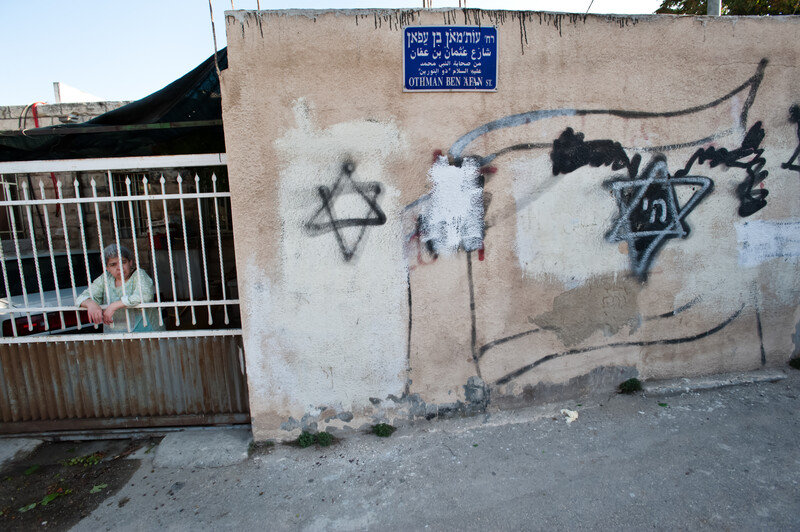Rights and Accountability 12 May 2016

A Palestinian woman stands near graffiti spray-painted on her home in the Sheikh Jarrah neighborhood in East Jerusalem in September 2011.
ActiveStillsLast November, Muhammad Abu Ta’ah arrived at his property in Sheikh Jarrah in occupied East Jerusalem only to find it had been fenced off by contractors.
On the three-dunum plot of land, construction had begun on a four-story, 70-office building that would make up the new headquarters for the private settler group Amana.
The property had once been part of an expansive 4,000 dunums (nearly 1,000 acres) of land which Israel expropriated in 1968, one year after its military occupied East Jerusalem. On that land, the state built the French Hill and Ramat Eshkol settlements, in addition to a government compound.
Much of this land had been owned by the Abu Ta’ah family. Until now, they had retained this last slice of property, located between a Palestinian hospital and a main thoroughfare, rented part of it to a car business and turned the rest into a large parking lot.
But now it belongs to Amana, the development arm of the Gush Emunim settlement movement, which has been integral to Israeli colonization of many parts of the occupied West Bank.
Amana also owns Al-Watan, a company based in the West Bank that buys Palestinian land for Jewish settlement and which has been involved in forging Palestinian signatures in dubious land purchases.
A new investigation by the settlement watchdog group Peace Now reveals how several Israeli ministries, led by the Israel Land Administration (ILA), went to extraordinary lengths to steal the Abu Ta’ah family’s last piece of land in order to give it to Amana.
The investigation shows that at every step of the way, the ILA helped Amana circumvent bureaucratic roadblocks to ensure the land became theirs.
“First they exempted Amana from the duty to hold a tender,” Hagit Ofran of Peace Now told the Tel Aviv newspaper Haaretz.
“Then they approved its building plan without it having any real rights to the land. Later the finance minister signed an expropriation in order to retrospectively whitewash the transfer of the land to Amana, and finally, today too, the state continues to fiercely guard this illegal behavior in court, instead of righting the wrongs and returning the land to its owners.”
The series of measures taken to expropriate the land are considered illegitimate by even some of the occupation’s biggest defenders.
The Abu Ta’ah family’s attorney Steven Berman served for 16 years as a legal advisor to the Jerusalem municipality, often defending the city against Palestinian lawsuits against illegal land expropriations.
“I have nothing against expropriating lands, which is a necessary process,” he told Haaretz.
“But in this case they deviated from all rules. What happened here is that ILA officials inappropriately used their power to help a close political body.”
The theft
The misdeeds go back to 1992, at the very beginning of then Prime Minister Yitzhak Rabin’s government, when the ILA agreed to give the land to Amana without a tender. But as Peace Now documents, the ILA was not the owner of the land.
The plan was put on hold, Peace Now speculates, because the Rabin government had published a study scrutinizing the ILA’s misdealings with settler organizations in East Jerusalem. The Klugman report found that the ILA had transferred 68 plots of land to rightwing settler organizations Elad and Ateret Cohanim.
But the agreement was revived in 1997, when Benjamin Netanyahu was first installed as prime minister.
That year, Amana submitted its construction scheme to the Planning Administration claiming that the ILA was the owner of the land, but leaving off their signature as they knew they weren’t the legitimate owners.
Several months later, the Planning Administration noticed the missing signature and twice requested it from Amana before receiving a copy purportedly signed by the ILA’s Amalia Abramovich.
Peace Now intimates that Abramovich’s signature may have been forged, as that was proven to have happened in another case.
Amana also sent the Planning Administration a letter from the ILA’s Avraham Nawi, claiming the land was expropriated.
The deal met another obstacle in 2005, when the Land Registrar refused to register the plot because there was no record that the plot was ever expropriated.
Nevertheless, in 2009, finance minister Yuval Steinitz signed the expropriation of an invented parcel of land including the Abu Ta’ah property that the ILA submitted for expropriation, therefore finalizing the theft of the land.
In court
The government is now defending the expropriation as the family takes it to court.
A Jerusalem court rejected the family’s petition in March. Despite agreeing that there were “flaws” in the approving plan, judge Arnon Darel found that invalidating the agreement would cause too much damage.
Now the Abu Ta’ah family is appealing the expropriation to the Israeli high court.
Jews have settled on Palestinian property ever since Israel’s expropriation of approximately 24,000 dunums (6,000 acres) of privately owned land in the aftermath of its 1967 de facto annexation of East Jerusalem.
Though just a sliver of the original 4,000 dunums expropriated in 1968, the back door deal between the government and a private settler group demonstrates the active hand the Israeli state has played in the continued dispossession of Palestinian land in East Jerusalem.
The Israeli rights group Ir Amim states that “the settlement enterprises in the middle of Palestinian neighborhoods over the last 30 years were seemingly carried out by private bodies, but were in fact rooted in government policy and enabled by it.”
The group has said the land grab in Jerusalem “create[s] a contiguous swathe of right-wing Jewish housing cutting through Sheikh Jarrah and sever[s] areas beyond it from the Old City and historic basin.”
Meanwhile, on Monday, dozens of Israeli settlers occupied a large residential building near the Old City and then performed prayers in its courtyard that overlooks al-Aqsa mosque.





